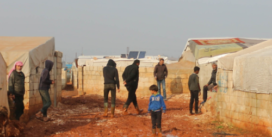- Using International Online Learning Modules to Engage Students in the Study of Critical Global Issues
- Upcoming Book Launch: Hearts of Freedom
- Announcing winners of the 2025 CARFMS Essay Contest
- The New York Declaration for Refugees and Migrants and its two Global Compacts: Addressing the Symptoms or the “Root Causes” of Forced Displacement?*
- Winter Newsletter, 2025, Issue 14
Moving Refugee Protection from Regional Divergence to International Convergence

 by Dr. James C. Simeon, Associate Professor, Head of McLaughlin College, and School of Public Policy and Administration, Faculty of Liberal Arts & Professional Studies, York University, jcsimeon@yorku.ca
by Dr. James C. Simeon, Associate Professor, Head of McLaughlin College, and School of Public Policy and Administration, Faculty of Liberal Arts & Professional Studies, York University, jcsimeon@yorku.ca
The international refugee protection regime is highly complex, regionally based, and far from uniform. There are, for example, at least three major United Nations Agencies that deal with refugees: the United Nations Office of the High Commissioner for Refugees (UNHCR); the United Nations Relief and Works Agency for Palestine Refugees in the Near East (UNRWA); and the International Organization for Migration (IOM). However, ostensibly, the United Nations Office of the High Commissioner for Human Rights (UNHCHR) also plays an important role in advancing and protecting the human rights of refugees.
Many other high profile and important international organizations arguably play a significant role here as well such as the International Committee of the Red Cross (ICRC), that fulfills its role in the supervision of International Humanitarian Law, and the International Council of Voluntary Agencies (ICVA), “a global network of non-governmental organizations that seeks to make humanitarian action more principled and effective.”[1] The ICRC’s role is especially germane given that fully 82 percent of all refugees come from only ten countries that have been wracked by protracted armed conflict for years, if not generations.[2] ICRC works quietly behind the scenes to ensure that all warring factions to an armed conflict adhere to the ‘laws of war’ and most importantly protect non-combatants along with the provision of its life-saving humanitarian efforts to all those on opposing sides who are affected by the war.[3] It is evident that even at the international level those who are forcibly displaced are attended to by a number of UN and other independent international organizations.
There are currently 148 State Parties to the 1951 Convention relating to the Status of Refugees and its 1967 Protocol.[4] These are the two international instruments that are at the center of the international refugee protection regime that provide a legal definition of who is a refugee.[5] But there is also the 1969 Organization of African Unity Convention Governing the Specific Aspects of the Refugee Problems in Africa that covers nearly all the States in Africa with its own definition of who is a refugee.[6] The 1984 Cartagena Declaration on Refugees has a definition of who is a refugee that builds on the 1969 OAU Convention definition.[7] The European Union (EU) has its 2011 Qualifications Directive with its own definition for the provision of international protection that includes subsidiary protection for those who do not qualify as Convention refugees.[8] In North America, Canada and the United States have broaden their definition of refugee protection to include the 1984 Convention Against Torture and Other Cruel, Inhuman or Degrading Treatment and Punishment.[9] And, there is also the 1994 Arab Convention on Regulating the Status of Refugees in the Arab Countries that has yet to be ratified and is being revised that has a broader definition of who is a refugee like the other regional refugee rights instruments.[10]
It is also important to keep in mind that there is a wide swath of States who are not State Parties to any refugee rights instruments, whether international or regional. This applies to India and many South East Asia States.[11] Indeed, there is an enormous resistance among States in this region of the world to sign the 1951 Refugee Convention and its 1967 Protocol. Various explanations have been offered as to why the States in this region of the world have not adopted international refugee rights instruments including that they are Eurocentric documents, with a narrow definition of who is a refugee, coupled with the fact they would impose financial contributions to specific groups of refugees.[12]
Taking all the foregoing into consideration it is evident that the current international refugee protection regime is a broad network of different regional configurations of States that follow their distinct definitions of who ought to receive refugee protection or some other form of international protection. What this clearly indicates is that depending on where a refugee applicant is in the world, he/she may or may not be determined to be a refugee. Indeed, in some countries, the person would not be accepted as a refugee because they do not have any laws to protect refugees. It is apparent then that the current configuration of the international refugee protection regime does not treat “like cases alike,” which is a fundamental principle of law. Further, it is also apparent that the present international refugee protection regime generates variations and unequal treatment of those who are seeking refugee protection. Accordingly, harmonizing standards and norms across all regions of the world ought to be a priority.
Related to this is the problem of diverging interpretations of refugee rights instruments, whether the 1951 Refugee Convention and its 1967 Protocol or the regional refugee rights instruments outlined above, at both the State level and the regional level. These regional refugee rights instruments are overseen by the various regional human rights courts such as the African Court of Human and Peoples’ Rights, the Inter-American Court of Human Rights, and the European Court of Human Rights and the Court of Justice of the European Union.[13] This clearly reinforces the regional variation that is already inherent within the international refugee protection regime. One solution that has been proposed to address this problem is an International Refugee Law Court that would resolve any differences in judicial interpretation at the States’ and the regional levels.[14] Assuming that all member States of the United Nations accepted such an International Refugee Law Court and bind themselves to its judgements, it could help to resolving any divergencies in judicial interpretation at the regional and State levels. Establishing such an international court is far from a simple and straightforward process that would require a broad-based consensus among a majority of the world’s States. Nonetheless, a number of early and tentative steps have been taken in this direction.[15]
When all the foregoing is taken into consideration in its totality, it is clear that what is required to try to ensure a more fair, equitable, and just international refugee protection regime is greater convergence across the regions of the world. This would allow, undoubtedly, for a far more fair, equitable, and just treatment of the world’s refugees and for the progressive advancement of their most fundamental human rights and human dignity.
Endnotes
[1] International Council of Voluntary Agencies, ICVA, About ICVA, https://www.icvanetwork.org/about-icva. (accessed April 11, 2021)
[2] UNHCR, Mid-Year Trends 2020, (Copenhagen, Denmark: Statistics and Demographic Section, UNHCR Global Data Service, 2020), p. 12 and Figure 2. https://www.unhcr.org/5fc504d44.pdf. (accessed April 11, 2021). It is also relevant to point out that just five countries account for over two-thirds of the world’s refugees: Syrian Arab Republic; Venezuela; Afghanistan, South Sudan and Myanmar. All, save Venezuela, have been war-torn for years.
[3] International Committee of the Red Cross, ICRC, https://www.icrc.org/en. (accessed April 11, 2021)
[4] UNHCR, State Parties to the 1951 Convention relating to the State of Refugees and the 1967 Protocol, https://www.unhcr.org/protect/PROTECTION/3b73b0d63.pdf. (accessed April 11, 2021)
[5] Convention relating to the Status of Refugees, Geneva, 28 July 1951, In force 22 April 1954, 1989 UNTS 137. Article 1A (2).
[6] Organization of African Unity (OAU), Convention Governing the Specific Aspects of the Refugee Problems in Africa, 10 September 1969, 1001, U.N.T.S. 45. Article 1(1) through to (6). 46 of the 54 States in Africa are State Parties to the OAU Convention. See the UN Treaty Series, OAU convention governing specific aspects of the refugee problem in Africa, https://treaties.un.org/pages/showDetails.aspx?objid=080000028010432f. (accessed April 11, 2021)
[7] Cartagena Declaration on Refugees, Colloquium on the International Protection of Refugees in Central America, Mexico and Panama, 22 November 1984. Section III, Paragraph 3. https://www.unhcr.org/about-us/background/45dc19084/cartagena-declaration-refugees-adopted-colloquium-international-protection.html. (accessed April 11, 2021)
[8] Office of the Journal of the European Union, L 337/9, Directive 2011/95/EU of the European Parliament and of the Council of 13 December 2011 on standards for the qualification of third-country nationals or stateless persons as beneficiaries of international protection, for a uniform status for refugees or for persons eligible for subsidiary protection, and for the content of the protection granted (recast), See Chapter 1, Article 2, and Chapter 5. https://eur-lex.europa.eu/LexUriServ/LexUriServ.do?uri=OJ:L:2011:337:0009:0026:en:PDF. (accessed April 11, 2021)
[9] For Canada see the Immigration and Refugee Protection Act (S.C. 2001, c. 27), Sections 95 and 96, https://laws.justice.gc.ca/eng/acts/i-2.5/ (accessed April 11, 2021) and for the US see the 1980 Refugee Act, https://www.govinfo.gov/content/pkg/STATUTE-94/pdf/STATUTE-94-Pg102.pdf. And see the US Department of Justice, Executive Office of Immigration Review, Fact Sheet, “Asylum and Withholding of Removal Relief Convention Against Torture Protections,”
https://www.justice.gov/sites/default/files/eoir/legacy/2009/01/23/AsylumWithholdingCATProtections.pdf. (accessed April 11, 2021)
[10] League of Arab States, Arab Convention on Regulating the Status of Refugees in the Arab Countries, 1994., Article 1, https://www.refworld.org/docid/4dd5123f2.html. (accessed April 11, 2021); League of Arab States’ Intervention to the Global Refugee Forum, 17-18 December 2019, Geneva, Plenary Session, Burden and Responsibility Sharing, https://www.unhcr.org/events/conferences/5dfa43674/statement-league-arab-states-arabic-english.html?query=Arab%20Convention%20on%20Regulating%20the%20Status%20of%20Refugees. (accessed April 11, 2021)
[11] Sreya Sen, “Understanding India’s Refusal to Accede to the 1951 Refugee Convention: Context and Critique,” Refugee Review: Re-Conceptualizing Refugees and Forced Migration in the 21st Century, eds. Petra Molnar and Brittany Lauren Wheeler, May 28, 2015, https://refugeereview2.wordpress.com/2015/05/28/understanding-indias-refusal-to-accede-to-the-1951-refugee-convention-context-and-critique/. (accessed April 11, 2021); Susan Kneebone, “Why is Asia Known as the Region that Rejects the Refugee Convention?” RLI Blog on Refugee Law and Forced Migration, April 15, 2019, https://rli.blogs.sas.ac.uk/2019/04/15/why-is-asia-known-as-the-region-that-rejects-the-refugee-convention/. (accessed April 11, 2021)
[12] Sara E. Davies, “The Asian Rejection? International Refugee Law in Asia,” Australian Journal of Politics and History, Vol. 52, No. 4, 2006, pp. 562-575.
[13] African Court of Human and Peoples’ Rights, https://www.african-court.org/wpafc/. (accessed April 11, 2021); Inter-American Court of Human Rights, https://www.corteidh.or.cr/index.cfm?lang=en. (accessed April 11, 2021); European Court of Human Rights, https://www.echr.coe.int/Pages/home.aspx?p=home. (accessed April 11, 2021); Court of Justice of the European Union, https://europa.eu/european-union/about-eu/institutions-bodies/court-justice_en. (accessed April 11, 2021)
[14] The Right Honourable Lord John Dyson, “The Interpretation of the Refugee Convention: Idiosyncrasy v. Uniformity,” in The Asylum Process and the Rule of Law, International Association of Refugee Law Judges, (Haarlem, The Netherlands: Manak Publications PVT LTD, 2006), pp. 21-36.
https://www.iarmj.org/images/stories/WorldConferences/6-2005-stockholm.pdf. (accessed April 11, 2021)
[15] See James C. Hathaway, Anthony North, Jason M. Pobjoy, “Supervising the Refugee Convention,” Journal of Refugee Studies 2013, Vol. 26, No. 3, pp. 323-326, and James C. Simeon, ed. The UNHCR and the Supervision of International Refugee Law (Cambridge: Cambridge University Press, 2013).
